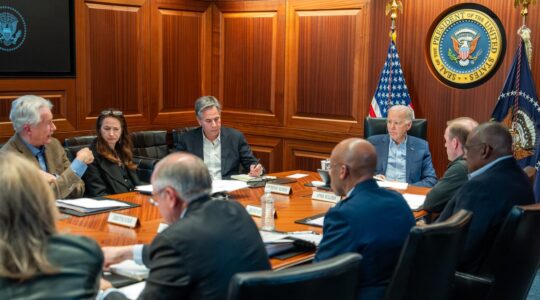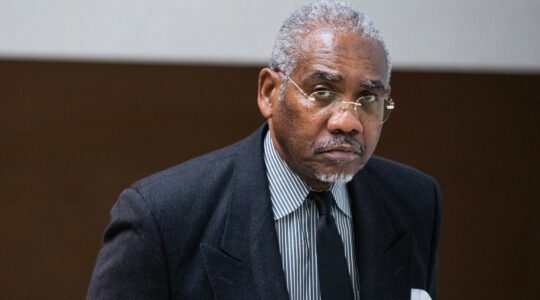WASHINGTON (JTA/Washington Jewish Week) — Jerusalem: To be or not to be part of Israel. That’s the question that White House administrations have tiptoed around for decades.
The State Department neither recognizes Jerusalem as Israel’s official capital nor views the eastern part of the city — captured from Jordan in the 1967 Six-Day War and subsequently annexed — as part of Israel. But Congress passed a law in 2002 that effectively recognized Jerusalem as Israel’s capital.
Presidents have been caught in the middle, cautiously balancing their pro-Israel rhetoric against longstanding U.S. policy.
That’s exactly where the Obama administration found itself last week after news reports revealed that the White House quietly had removed all references to Jerusalem as being part of Israel from a collection of photos on its website.
The Weekly Standard reported Aug. 9 about a set of White House photos from Jerusalem that had been scrubbed of all explicit references to Israel. Whereas a caption for a shot of Vice President Joe Biden once said that he was dining at the “David Citadel Hotel in Jerusalem, Israel,” it has since been altered to read just “Jerusalem.”
Some pro-Israel activists were incensed by the change, charging a White House whitewash and claiming definitive proof that President Obama disdains Israel. To others it appeared that the president was kowtowing to pressure from the State Department, which recently had reiterated its policy against recognizing Jerusalem as part of Israel.
But the White House upon discovering the captions referring to “Jerusalem, Israel” — and with the Obama administration’s policy on Jerusalem being no different than those of his predecessors in the Oval Office — corrected them to reflect longstanding U.S. policy.
“U.S. policy for more than 40 years has been that the status of Jerusalem should be decided in final-status negotiations between the parties,” a White House official said last week in response to an inquiry about the matter. “As in prior administrations, the White House photo captions should reflect that policy.”
For the White House, Jerusalem is just Jerusalem until the Israelis and Palestinians ink a peace deal.
A virtual tour of the White House’s online archives shows that President George W. Bush had a similar photo rule: pictures of him in Jerusalem do not denote that the city is in Israel. During one such trip to the Jewish state in 2008, for instance, Bush visited “Yad Vashem, the Holocaust Museum, in Jerusalem,” according to the caption written by the Bush administration.
“The status of Jerusalem will be ultimately determined by the interested parties,” Bush said in 2001.
Former Bush administration official Elliot Abrams recalls matters differently. He told the Washington Post last week that “the Bush administration did not have a hard-and-fast rule that prohibited referring to Jerusalem that way at all times and in all statements and press releases.”
If nothing substantial had changed from Bush to Obama, why did the photo snafu receive so much attention?
First there was the public relations gaffe: Jerusalem’s status is a highly charged political issue, and the Obama administration was caught red-handed fixing an embarrassing mistake.
Perhaps more significant, however, the error came just as the U.S. Supreme Court is preparing to examine the constitutionality of the State Department’s policy on Jerusalem. The litigants in a case scheduled to be heard by the court in the fall session want their Jerusalem-born son to have his birthplace listed as “Jerusalem, Israel” on his passport, as is permitted by a 2002 federal law.
But the State Department has not implemented that law (under either Obama or Bush) because it says the law violates the department’s ability to set foreign policy. The Israeli-Palestinian peace process is so sensitive, the State Department maintains, that it is critical that U.S. passports only say “Jerusalem.”
Presidents often have found themselves at odds with Congress over Jerusalem. President Truman favored an “international regime for Jerusalem,” while Presidents Carter, Reagan and Clinton all believed that negotiation should resolve the status of Jerusalem.
Congress has been more hawkish on the issue. In 1995, Congress overwhelmingly passed the Jerusalem Embassy Act, which mandated the relocation of the U.S. Embassy in Israel to Jerusalem from its current location in Tel Aviv.
But since 1998, every sitting president has suspended the relocation via an executive order that is reissued every six months that says the delay is “necessary in order to protect the national security interests of the United States.”
Long-needed renovations at the U.S. Embassy building in Tel Aviv have not been carried out due to uncertainty over how long the embassy opposite the beachfront.will be located there.
While the U.S. Congress has already made up its mind about the embassy and Jerusalem, U.S. policy as set by the president is waiting for something else: the Israelis and the Palestinians to come to agreement.
With the stalemate between the two parties showing no signs of ending, that could take a very long time.





